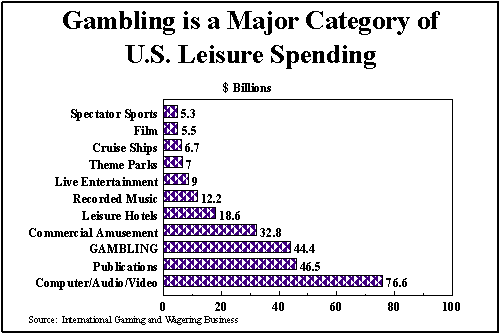
I. Gambling in the United States
"Gambling is inevitable. No matter what is said or done by advocates or opponents of gambling in all its various forms, it is an activity that is practiced, or tacitly endorsed, by a substantial majority of Americans."
-- Commission on the Review of National Policy toward Gambling, 1976, p.1.
In 1973, the Commission on the Review of National Policy toward Gambling was created to study gambling in the United States. The Commission began its report with the above statement and it is appropriate for this report. While the statement is merely the opinion of the Commission and cannot be easily proven, it is easy to understand how they formed their opinion. If you read the history section of this report, you will see that the popularity of legal gambling has waxed and waned, but has never disappeared. Illegal gambling, although we are ignorant about the full extent of it, has shown remarkable endurance. One industry observer noted, "There is a public demand to gamble, but there is no public demand for legalized gambling."1 The acceptance of gambling today can be seen by the substantial numbers of players of the various state lotteries and similar illegal games.
This report will use the terms gambling and gaming interchangeably. Within the gambling industry, the term gambling has fallen into disfavor and is being replaced by gaming.
Legal Gaming Has Expanded Greatly Throughout the Country. Legal gambling activities include state lotteries; parimutuel betting on horses, greyhounds, and jai-alai; sports book-making; card games; keno; bingo; slot machines; progressive slot machines; video poker machines; video keno machines; video blackjack machines; and video roulette machines. Not all of these are legal in all places. These activities have grown tremendously, especially when considering that virtually all have been only recently legal in most states. This growth of gambling has been remarkable: in 30 years gambling has transformed itself from sinful to well accepted.2 But the spread has been inconsistent, with each state selecting the type of gaming that it supports or at least condones. Some states have casinos, but no lotteries. Other states have lotteries, but no casinos. Some have both.
Illegal gambling still exists and, by many accounts, flourishes.3 Not surprisingly, there is not a lot of data about illegal gambling. The most popular forms of illegal games are "numbers," which is essentially a lottery, and betting with bookies, typically sports betting. Sports betting, in particular, is thought to amount to a large sum. Some analysts think it is the largest category of gambling after casino games.4
Views on Gambling Vary. Gambling is regarded by some as a vice, a sinful activity which corrupts society. Others view gambling simply as a harmless form of entertainment. These contrasting views help shape the regulation of gambling. The regulation of gambling is unusual as society regulates gambling like no other business.5 Overall, society has taken a cautious view of gambling. Only limited types of games are legal. Gambling is heavily regulated because of concerns about criminal involvement. Because of the large amount of cash involved, gambling is an attractive target for criminals.
Others look at gambling in economic terms. Legalized casino gambling, whether in Las Vegas, Atlantic City, or on Indian land, rose out of the desire for economic stimulus, although other factors also played a role. Lotteries are regarded by state governments as a revenue-generating tool.
Why has gambling grown? There are a variety of possible explanations.6 One explanation for the spread is that states need the revenue and are hooked on gaming funds. Another related view is that government has said it is acceptable, hence people are more willing to participate. Some observers attribute the domino effect. The domino effect of gambling occurs when one state legalizes gaming, other states legalize gambling so they do not lose money to their neighbors. The spread of lotteries can be seen as an example of the domino effect. The current wave of legal lotteries started in New Hampshire, spread to other North-Eastern states, and then across the nation. Right now, the states that do not have lotteries are clustered primarily in the South. Similarly, riverboat casinos were first legalized in Iowa, then Illinois, followed closely by Missouri, Indiana, Louisiana, and Mississippi.
Regardless of viewpoint, there is little doubt that gambling is a very popular activity in the United States. By 1994, every state except Utah and Hawaii had some form of legal commercial gambling. Casino gambling, including Indian gaming, is legal in 27 states and most of the casinos have been built in the last 5 years.7
The Gaming Sector is a Large Entertainment Industry. In 1995, gambling in the United States grossed over $40 billion in revenues. Although this total does not include illegal gaming, it is still quite large compared to some other entertainment industries. The same year, the estimated receipts for amusement parks were $7 billion, including admission fees, sales of food and beverages, and other sales. The estimated receipts for movie theaters were $5.5 billion.8 Gambling is clearly a major form of entertainment.

Another way to look at gambling's relative popularity is through the public's participation. In 1993, the last full year before the baseball strike, 70 million fans went to the ballpark, while 92 million visited casinos.
The preceding comparisons were made using gross revenues, but the amount of money people spend gambling is usually measured by one of two methods.
The handle is popularly used for measurement, but it can be misleading. Because it is the amount wagered before payment of prizes, the handle tends to inflate the economic importance of gambling. Gross revenues are a better measurement when comparing gaming to the rest of the economy.
An example may help illustrate the difference. A player spends a dollar playing video poker and wins $4. The $4 is fed back into the machine until she loses the $4 plus her original dollar. In this example, the handle would be $5. But the gross revenue and the amount the player lost out of pocket is only $1.
There Are Four Major Types of Legal Gambling. According to one well-known researcher, these include charitable gaming, parimutuel betting, casino gaming, and lotteries.9 There is some potential confusion that may arise from these definitions. The definition of casinos include what most of us would expect, i.e. the Las Vegas-style casinos that are found in Nevada, Atlantic City, and a few other locales. In California, cardrooms advertise themselves as casinos, but they don't offer the games that one expects from casinos, namely banked games, especially slot machines. The cardrooms found in California are an anomaly and don't fit into the major categories. They are discussed later in Chapter V on "Gambling in California." The following chart shows the relative size of the different types of gambling.
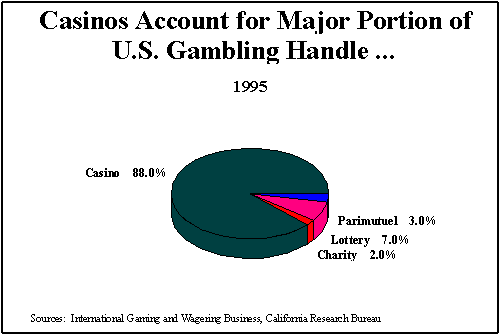
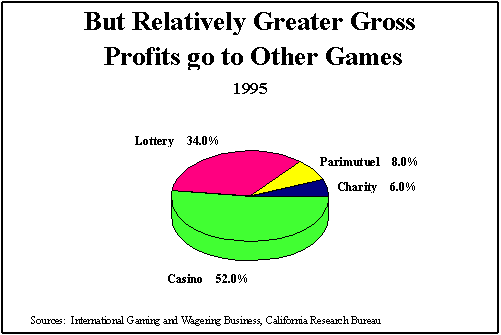
Charitable Gambling
Charitable gambling is run for the benefit of nonprofit organizations, although the nonprofit may not necessarily be the operator of the games. Some examples of charitable gambling are PTA Monte Carlo nights and church raffles. The most popular form of charitable gambling is bingo. Charitable bingo is legal in all but five states. In California, bingo is the only charitable game that is legal.
Despite the nonprofit nature of charitable gaming, it has come under criticism. One reason is that it is the area of gambling that is the least regulated. As the tables and graphs show, it accounts for a significant amount of money even if the total is dwarfed by that of casinos. According to some industry observers, there are serious problems of fraud, theft, cheating, and accounting irregularities.10 In California, charitable games have been victimized by robbers because of the large amount of cash generated by bingo.
Parimutuel Wagering
Parimutuel wagering refers to the type of gambling where the total prize pool is based upon the amount of money wagered. The more money gambled, the bigger the prize. Horse racing is the best known and widespread parimutuel betting event. Horse racing is the only form of partimutuel wagering legal in California.
Dog racing and jai-alai are less popular parimutuel betting events. Dog racing operates in 17 states, while jai-alai is legal in just three: Connecticut, Florida, and Rhode Island. Dog racing is, as suggested by the name, a race among greyhounds who chase after a mechanical rabbit. Jai-alai is a game played by two or four persons and its action is similar to handball.
Parimutuel wagering has not been able to compete well with the myriad of new forms and types of gambling. Observers attribute its decline to the complicated nature of the sports, especially for the new gambler.11 The industry is changing, however, some racetracks are adding casino games. Situating casino games with the track exposes other gamblers to horses and thereby parimutuel wagering. In turn, this may lead to increased parimutuel participation.
Lotteries
Lotteries have a long tradition in this country. They were used to raise money in support of the first North American colonies. Lotteries continued to be used by the original thirteen colonies to raise necessary revenue for the development and the successful independent operation of the new settlements. Though early lotteries were successful in raising money, the scandals from crooked operations strengthened the hand of antigambling forces, eventually leading to prohibition of lotteries in many states. From 1894 to 1964 no legal government-sponsored lotteries operated in the United States. The long and colorful history of lotteries in the United States is described in more detail in the history section of this report.
Legal Lotteries Experienced a Rebirth in the 1960s. The first legal lottery in the twentieth century was the New Hampshire Sweepstakes which began on March 12, 1964. Other North-Eastern states quickly followed. In 1981, Arizona became the first state west of the Mississippi to authorize a lottery. Currently 37 states and the District of Columbia operate lotteries.
Casino Gaming
Casino gaming is the largest part of the commercial gambling market. Casino gaming continues to grow in popularity, fueled by the creation of new casino destinations and the expansion of existing casino locales.
A casino is usually characterized by the offering of banked games. Banked games are where the house is banking the game and basically acting as a participant. That is, it has a stake in who wins. In contrast in a non-banked game, like the lottery, the operator does not care who wins. As noted earlier, cardrooms such as those in California are not included. They are often called casinos, but they do not offer banked games.
Currently, ten states have legalized some form of commercial, non-tribal casino gambling with banked games. These are what the typical observer would call Las Vegas style casinos.
The following chart lists the states and the year each made casino gambling legal. Note the rapid growth since 1989.
|
State |
Form of Casino Gaming |
Year of Legalization |
|
Nevada |
Unlimited Stakes |
1931 |
|
New Jersey |
Unlimited Stakes |
1976 |
|
South Dakota |
Limited Stakes |
1989 |
|
Iowa |
Riverboat |
1989 |
|
Colorado |
Limited Stakes |
1990 |
|
Illinois |
Riverboat |
1990 |
|
Mississippi |
Riverboat, Dockside |
1990 |
|
Louisiana |
Unlimited Stakes, Riverboat |
1991 |
|
Missouri |
Riverboat |
1992 |
|
Indiana |
Riverboat |
1993 |
This chart does not include Indian gaming, which is discussed later.
For almost 50 years casino gaming was only legal in Nevada. There, legal state-regulated gaming was dominated by organized crime. In the late 1950s, the state first permitted publicly-held companies to own and operate gaming facilities, which eventually led to the entrance of companies such as Hilton and Ramada into the industry, improving the industry's reputation. It was at this time that intense gaming activity spread from downtown Las Vegas to the Strip and began to grow in Reno and Lake Tahoe. Since then, gaming in Nevada, and especially Las Vegas, has become a multibillion-dollar industry that attracts millions of people each year.
Nevada enjoyed a long period with little legal competition. New Jersey's statewide referendum legalized gambling in 1976. The first Atlantic City casino opened in 1978. Since then, eight other states have legalized casino type gambling.
The first state that authorized one of the new wave of legalized casinos was in South Dakota. In 1989, South Dakota legalized limited-stakes casino gambling in the historic mining town of Deadwood. In 1990, Colorado followed when voters in that state approved limited-stakes casino gambling in three former mining towns: Cripple Creek, Black Hawk, and Central City.
In 1989, Iowa and Illinois legalized riverboat casino gaming and, in April 1991, Iowa launched the first gaming vessel in recent U.S. history. Riverboat casinos are now legal in six states: Illinois, Indiana, Iowa, Louisiana, Mississippi, and Missouri. Currently there are about 65 boats operating in these states. The type of gaming allowed on riverboat casinos varies by jurisdiction. Generally, the states allow the playing of traditional casino games such as blackjack, roulette, and slots.
Riverboats Present a Good Example of the Domino Theory of Making Gambling Legal. Illinois' statute was more liberal than Iowa's, leading to a riverboat regulation war. Gaming revenues began to decline in Iowa in 1993 when the riverboats moved out of Iowa to locations with more favorable regulations. Iowa had established a $5 maximum wager and a $200 per customer loss limit. Illinois did not have a wager or loss limit and the riverboat casino centers in Illinois were closer to population centers. In 1994, in an effort to reverse the industry's decline, the voters in Iowa voted to eliminate wager and loss limits.
The advent of riverboat gaming also led to increased Indian gaming, when Indian tribes were allowed to operate the same kinds of gambling allowed within a state. A Nebraska tribe even attempted to buy property in Iowa to open a casino.
Riverboat Gaming Has Captured 20% of the Casino Market Share.
Mississippi now has more gambling square footage than Atlantic City. The
International Gaming and Wagering Business magazine reported casino revenue
figures for 1995 as shown in the chart below.12
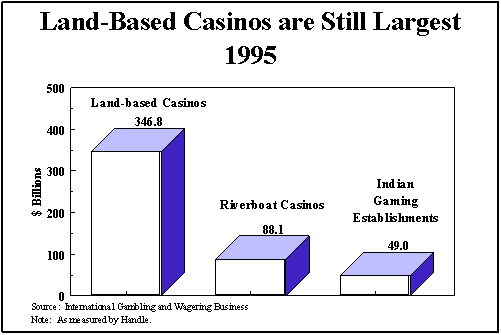
There are two major categories of riverboat casinos, excursion and dockside. Excursion riverboats cruise along some waterway, while dockside casinos are tethered to the shore during operations. Dockside casinos are usually just a land-based casino on pilings or a floating, but not navigable, platform.
The excursion requirement was important in the beginning because it provided a subtle transition into legal gambling, giving the public an impression that the gambling could be isolated and controlled. The gambling takes place in a restricted location, namely on a boat traveling on the waterways and the amount of activity is limited by the length of the excursion. If the excursion is three hours, then the amount of gambling is limited to the three hours on the river, plus another half hour or so while the boat is tied up for loading and unloading. Many analysts believe that the perception that riverboat gambling would be physically contained made legal gambling an easier sell to the voters.
Some states are eliminating the law concerning the cruising requirement. Dockside casinos are more popular because some customers do not like to be cooped up for a set period of time, and some do not like having to leave when the ship is moored. Eliminating the cruising requirement also reduces the possibility of accidents on the waterways. Mississippi has no cruise requirements on their riverboat casinos. Other states allow for some flexibility for bad weather and choppy waters. According to a representative of Hilton Hotels Corp., which operates a riverboat casino in New Orleans, "admission revenues rise 40% and gambling revenues increase as much as 20%" when the ship is kept at the dock.13 The riverboat casino industry is trying to convince other states to eliminate the cruising requirement. In this way, riverboat gambling has become an indirect path to land-based gaming.
In 1992, Louisiana became the third state to legalize land-based casino gambling. Voters narrowly approved legislation to establish a riverfront facility in New Orleans. The legislation permits a single facility in downtown New Orleans and a temporary facility to be operational while the permanent facility is under construction. On November 21, 1995, the partnership that owns the casino venture filed for Chapter 11 bankruptcy. The temporary casino was closed and the construction of the new facility was halted while the organization under went restructuring. Harrah's is the lead partner in this effort. New Orleans is the first casino in a major city other than Nevada. Concerns about the industry's survival were allayed when casino gaming was ratified by a large margin of voters in a referendum in November 1996.
Las Vegas Expands to Meet the Challenge From Competing States. With competition from new gaming locales and other parts of the entertainment industry, the owners of major casino properties in Las Vegas have not stood still. While other markets rely on their local population, the Las Vegas market is almost entirely reliant upon the tourist business that the casinos generate.
Many of the major developers are turning Las Vegas into a family-oriented destination resort, complete with grand spectacles and theme parks. In late 1993, Circus Circus' pyramidal Luxor opened, featuring an Egyptian theme and amusement park. Shortly thereafter, the Mirage's Treasure Island opened with a pirate theme and a regularly scheduled sea battle outside the facility. The new MGM Grand has a Wizard of Oz theme park. Las Vegas visitation in 1994 was very strong, up approximately 24% from 1993. Almost 30 million visitors came in 1994, approaching the level of Atlantic City.
As the following chart shows, the big operators in casino amusement are large publicly-owned companies. If the merger between Hilton and Bally's goes through, it will create the largest company in the country, surpassing Harrah's.
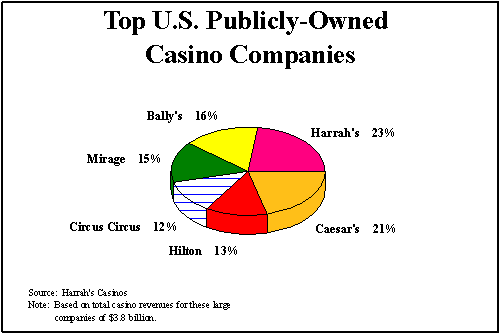
Indian Gaming
Indian tribes have used their position as sovereign entities to develop a number of gaming establishments. Indian casinos operate in 22 states: Arizona, California, Colorado, Connecticut, Idaho, Iowa, Kansas, Louisiana, Michigan, Minnesota, Mississippi, Montana, Nebraska, Nevada, New York, North Carolina, North Dakota, Oklahoma, Oregon, South Dakota, Washington, and Wisconsin. This number is expected to grow.
The opportunity for economic development through gambling has piqued the interest of many Indian tribes. The U.S. Bureau of Indian Affairs reported that there are 545 federally-recognized Indian tribes in 35 states. Gambling on Indian-owned land has grown in popularity and there are approximately 150 to 175 casinos and bingo halls currently in operation.14
Gambling has represented an opportunity for tribal self-reliance and a chance to reverse some of the poverty that has affected many of the tribes. Indian tribes started offering games similar to those being offered by charities, such as bingo. In order to gain a competitive advantage, some tribes began offering high-stakes bingo, an option that was not available to the charities because of state laws. The growth of Indian gaming led to many court battles, including some important ones in California. This issue is covered in more detail in the section on Indian Gaming.
Illegal Gambling
Illegal gaming is popular, though its popularity and prevalence are difficult to measure. An estimated $32 billion was wagered illegally in 1986, resulting in gross revenues of approximately $5.6 billion.15 Another estimate places the illegal gaming handle at about $48 billion with gross revenues of $2.4 billion.16 The most significant forms of illegal gambling in the United States are numbers, betting with bookmakers or bookies, and sports pools or sports cards. The "numbers" game is similar to the lottery game. Bettors select numbers and hope theirs match the winning numbers that have been randomly selected.
Betting with bookies usually involves placing bets on the outcome of a certain event, such as a sporting event. Sports cards and pools are also bets involving sporting events. Most sports bets are between friends or acquaintances. A smaller amount is made with bookies and the bets are usually under $100.
All Types of Gambling Have Shown Growth. Although there are numerous types of gaming, a common theme is that they are all growing. The following charts show the growth in the different categories of legal gambling.
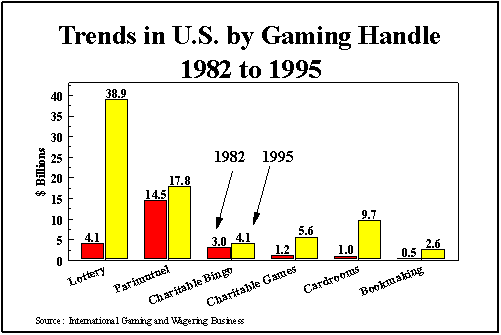
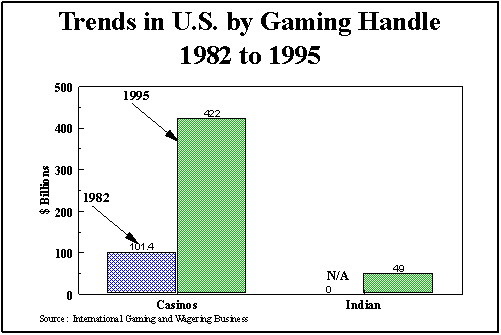
Gambling is Usually Regulated by a Commission Form of State Agency. Currently in the United States, 48 of the 50 states have legalized some form of gambling. Utah and Hawaii are the exceptions. Regulation of gambling activities across the nation is usually done by commissions.
Parimutuel Wagering
Lotteries
Card Rooms
Casino Gaming
1996 Election Results Suggest Gaming Will Continue to Expand. Prior to the elections, there was concern within the industry that a backlash was beginning to build. As the history section of this report discusses, such a backlash has occurred in the past. There was some evidence that a backlash was starting. Factors slowing growth include:17
In a reverse for the industry, a federal study commission on gambling has been created despite the opposition of the gaming industry and gambling had failed to gain approval in new states. During 1994, the industry suffered some losses in important elections in Florida and Missouri.
However, the 1996 elections changed that view.18 The industry recorded the following major victories:
Some observers have drawn different conclusions from the election as there were also losses for gambling interests.19 Nevertheless, there has never been such victories for gaming interests in state-wide contested elections. The vote was even more dramatic when one considered the criminal convictions resulting from Louisiana's gambling scandals. (Discussed in more detail in the Politics and Gambling section of the report.)
The Internet may be the source for the largest growth in gambling. The World Wide Web has three hundred gambling-related sites, some of which have set up operations offshore. The Attorney General of Minnesota has filed a suit against a service that plans to offer sports bookmaking.
Return to the Return to the Table of Contents